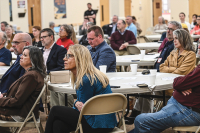The excitement in a bag full of books
 Recently I returned from a trip to the library with a bagful of books. When handling these books in the library, flipping through the pages and reading the blurbs, I experienced a familiar excitement, that thrill felt by all booklovers when they find a book promising enjoyment and worth.
Recently I returned from a trip to the library with a bagful of books. When handling these books in the library, flipping through the pages and reading the blurbs, I experienced a familiar excitement, that thrill felt by all booklovers when they find a book promising enjoyment and worth.
Later that evening, however, as I unpacked the bag along with some groceries, my earlier enthusiasm gave way to puzzlement. As I looked over the books this time, I wondered why I had selected them. What was I thinking?
Here, for example, was Alexander McCall Smith’s What W.H. Auden Can Do For You (Princeton Press, 137 pages, $19.95). I have long admired certain of Auden’s poems — every year I teach with great pleasure his “Musee Des Beaux Arts,” which for me speaks volumes on suffering and indifference — and the brevity of Smith’s book appealed to me in terms of reading it for review, but now I felt utterly removed from the little book. Instead, I found myself wondering why Smith called himself “Alexander McCall Smith.” Why not “Alex” or “Call?” Does he introduce himself that way? Are there other Alexander Smiths who are well-known authors?
Then there was Tom Nissley’s A Reader’s Book of Days: True Tales from the Lives and Works of Writers for Every Day of the Year (W.W. Norton & Co., 448 pages, $26.95). Here was one of those “dipper books” I mentioned in a previous review, one of those compilations that usually attracts me. This day-by-day literary companion did excite some interest. I looked up my birthday, of course, and was pleased to find that I shared the date with Ralph Ellison and Robert Lowell, two authors whom I have long admired. After perusing the book for half an hour — the thumbnail sketches of certain authors and the literary anecdotes make for worthy reading — I put it aside, wondering yet again why I had lugged this hefty beast home. If you’re in need of a book of days from a literary perspective, this book will delight you, but I am unfortunately one of those forgetful souls who would buy the book, read it daily for perhaps a week, and then forget to open it again for another six months.
To the Letter: A Celebration of the Lost Art of Letter Writing (Gotham Books, 464 pages, $27.50) provides a wonderful history of letters, letter writing, and the monetary value of old letters. I was snookered into taking the book because of the author’s descriptions of the Roman letters found at Vindolanda near Hadrian’s Wall in Britain, letters preserved for nearly 2,000 years by the mud covering a Roman garbage dump. This account of Vindolanda I read avidly, but then I put the book aside. (I did enjoy reading author Simon Garfield’s account of Elvis Presley’s letter and subsequent visit to President Nixon. Strange times ….)
Next was Charles Krauthammer’s Things That Matter: Three Decades of Passions, Pastimes and Politics (Crown Forum, 387 pages, $28). Several laudatory reviews had brought this book to my attention, and though, for want of a television set, I don’t watch Fox News (my father watches Fox and other news channels for hours every day, and then wonders why he is depressed), I nevertheless decided to take the book home. Here were several essays well worth my time, especially those on literature and culture, the ones on baseball — Krauthammer is a Nationals’ fan — and the ones on Israel. Though some of the topics were a little dated, I did find myself engrossed by Krauthammer’s style. He is bright; he doesn’t talk down to his readers; he is a craftsman.
Related Items
Finally, there was Abbie Reese’s Dedicated to God: An Oral History of Cloistered Nuns (Oxford University Press, 247 pages, $34.95). Over a period of six years, Reese interviewed members of a Poor Claire order in Rockford, Illinois. These nuns live shut away from the world; they rarely emerge from the convent, and visitors, including family, may visit only rarely, and even then must speak to the nuns through a grill. They spend most of their day in prayer and manual labor.
Some among us probably regard such a choice as a waste of a human life while others would contend that the prayers of these contemplatives carry the burdens of the world. As for me, I am awed not only by the decision of these women to join such an order, but by their courage as well.
It is a great mystery to me, this sense of being called to such a harsh life. I know of a young woman, sent by her parents to an orthodox Catholic college, who arrived on campus with a tattoo on her neck, unnaturally colored hair and several piercings in each ear. She spent the first two years in the school playing the rebel, barely avoiding expulsion on several occasions, but by the time she had graduated, she had announced, tattoo and all, that she was joining the Carmelites, also a cloistered order. She lives now in a convent in New York State and is, according to one of her friends, contented and even joyful in her choice.
What intrigued me most about Reese’s book was not therefore the joy of the nuns, which is stressed on the blurbs on the back of the book, but the depths of their courage. (And anyone who thinks these women are “running away” from the world needs to examine the book). To offer one’s life in this way for God — or for anyone or anything — is beyond my comprehension.
These women have a courage I lack — the courage to leap. They have a courage I admire.









